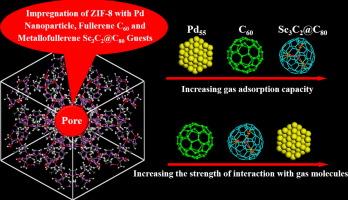Simulation study on the impregnation of ZIF-8 with Pd nanoparticle, fullerene C60, and metallofullerene Sc3C2@C80 guests: Analyzing guest effectiveness for enhancing CO2 uptake capacity
IF 6.9
2区 材料科学
Q2 CHEMISTRY, PHYSICAL
引用次数: 0
Abstract
Today, it is accepted that CO2 from the burning of fossil fuels plays a major role in global warming. Therefore, in recent years, to reduce the CO2 concentration in the atmosphere, the synthesis and design of porous materials such as ZIFs have attracted the attention of many researchers. Improving the adsorption capacity of the synthesized ZIFs is very necessary to make them suitable for industrial applications. For this purpose, various strategies such as modification of linkers, catenation, introduction of open-metal sites and impregnation with fullerene and metallic nanoparticles have been proposed and investigated. In this study, using Grand Canonical Monte Carlo (GCMC) and molecular dynamics (MD) simulations, the effect of ZIF-8 impregnation with different guest molecules such as Pd nanoparticles, C60 fullerene and Sc3C2@C80 metallofullerene on CO2 adsorption capacity has been investigated and the performance of the guest molecules are compared. The simulation results show that the pristine ZIF-8 has three special adsorption sites I, II and III in its structure. While increasing the concentration of guest molecules (i.e. the number of 1 and 3 guest molecules) in ZIF-8 by creating a new and more active IV site and thus increasing the number of adsorption sites from 3 to 4, increases the CO2 adsorption capacity. While higher concentrations of guest molecules (i.e. 6 and 9 guest molecules) decrease the CO2 adsorption capacity by blocking the pores of ZIF-8 and reducing the pore volume and surface area. The simulation results also show that the role of guest molecules in increasing gas adsorption capacity can be determined as the trend of Sc3C2@C80 > C60 ≥ Pd. The simulation results show that despite having a lower gas adsorption capacity, Pd nanoparticles have stronger interactions with CO2 molecules and cause stronger CO2 gas adsorption. In this study, the role of guest molecules in increasing the strength of interaction with CO2 gas was determined as Pd > Sc3C2@C80 > C60. The results of this study provide a new and broad view of the impregnation phenomenon of ZIFs as well as the function of different guest molecules in the impregnation phenomenon. It is expected that the results of this study can help researchers in this field to choose the appropriate guest molecule in the impregnation phenomenon in order to improve the gas adsorption capacity.


钯纳米粒子、富勒烯C60和金属富勒烯Sc3C2@C80客体浸渍ZIF-8的模拟研究:分析客体对提高CO2吸收能力的有效性
今天,人们普遍认为燃烧化石燃料产生的二氧化碳是造成全球变暖的主要原因。因此,近年来,为了降低大气中CO2浓度,多孔材料(如ZIFs)的合成和设计引起了许多研究者的关注。为了使合成的ZIFs适合工业应用,提高其吸附性能是非常必要的。为此,人们提出并研究了各种策略,如连接剂的修饰、链链化、开放金属位点的引入以及富勒烯和金属纳米颗粒的浸渍。本研究采用大规范蒙特卡罗(GCMC)和分子动力学(MD)模拟,研究了不同客体分子(如Pd纳米粒子、C60富勒烯和Sc3C2@C80金属富勒烯)浸渍ZIF-8对CO2吸附能力的影响,并比较了客体分子的性能。模拟结果表明,原始的ZIF-8在其结构中具有三个特殊的吸附位点I、II和III。而增加ZIF-8中客体分子的浓度(即1和3客体分子的数量),通过创建一个新的和更活跃的IV位点,从而使吸附位点的数量从3个增加到4个,增加了CO2的吸附能力。而较高浓度的客体分子(即6和9客体分子)通过堵塞ZIF-8的孔隙,减小孔隙体积和比表面积而降低CO2的吸附能力。模拟结果还表明,客体分子对气体吸附容量增加的作用可以确定为Sc3C2@C80 >; C60 ≥ Pd的趋势。模拟结果表明,尽管Pd纳米粒子的气体吸附能力较低,但与CO2分子的相互作用较强,对CO2气体的吸附能力较强。在本研究中,客体分子增加与CO2气体相互作用强度的作用确定为Pd >; Sc3C2@C80 >; C60。本研究结果为zif的浸渍现象以及不同客体分子在浸渍现象中的作用提供了新的广阔视角。期望本研究结果可以帮助该领域的研究人员在浸渍现象中选择合适的客体分子,以提高气体吸附能力。
本文章由计算机程序翻译,如有差异,请以英文原文为准。
求助全文
约1分钟内获得全文
求助全文
来源期刊

Applied Surface Science
工程技术-材料科学:膜
CiteScore
12.50
自引率
7.50%
发文量
3393
审稿时长
67 days
期刊介绍:
Applied Surface Science covers topics contributing to a better understanding of surfaces, interfaces, nanostructures and their applications. The journal is concerned with scientific research on the atomic and molecular level of material properties determined with specific surface analytical techniques and/or computational methods, as well as the processing of such structures.
 求助内容:
求助内容: 应助结果提醒方式:
应助结果提醒方式:


